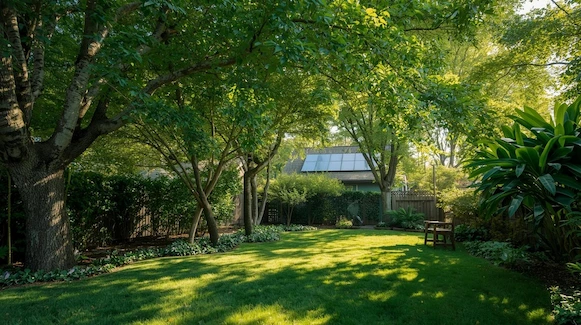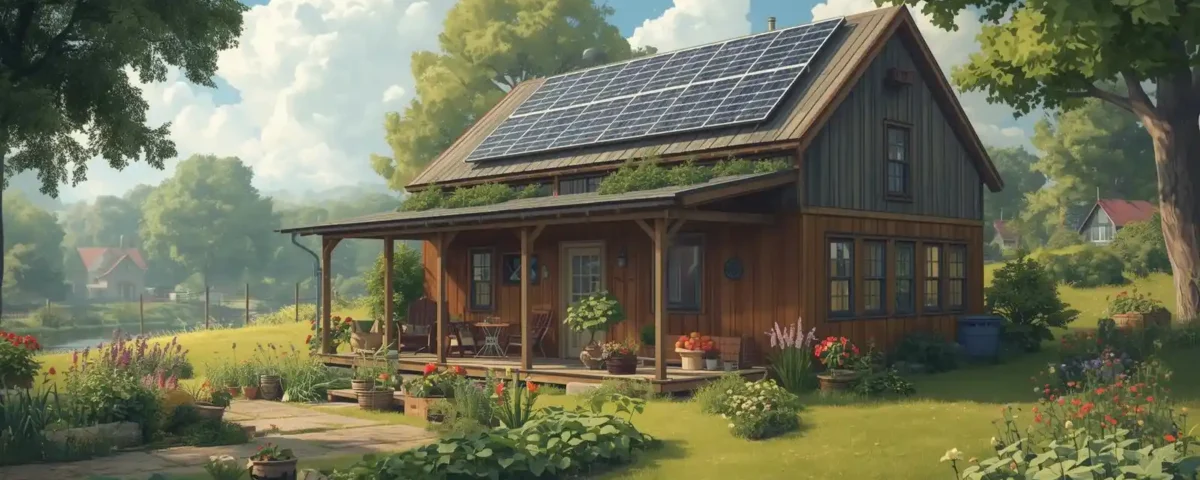
Hybrid vs. All, Foam Mattress: The Ultimate Guide to Choosing Your Best Sleep
September 28, 2025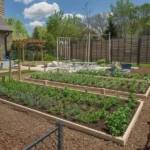
Ultimate Guide to Hugelkultur Beds: Sustainable & Self-Watering
October 5, 2025Reshaping the American Dream
Do you dream of living more self, sufficiently, eating healthier, and feeling a stronger connection to the land, but get stuck on the image of needing acres of farmland, endless free time, or old, fashioned know, how? For many, the idea of homesteading feels out of reach before it even begins.
The truth is, the desire for wholesome food, financial independence, and a closer relationship with nature often collides with the reality of modern life, crowded cities, packed schedules, and rising costs. But here’s the shift: homesteading today isn’t about abandoning your current life. It’s about enriching it. Modern homesteading is flexible, realistic, and designed to fit your circumstances, no matter where you live or how much time you can give.
This guide will take the mystery out of modern homesteading. Inside, you’ll find practical steps, real, world solutions, and expert insights that show you how to cultivate resilience, health, and purpose right where you are. From small, scale gardening to simple sustainable practices, you’ll learn how to weave self, sufficiency into daily life without sacrificing the conveniences you value. You’ll also discover how to overcome common hurdles and connect with a growing community of people who are redefining what the American dream looks like today.
What Exactly is Modern Homesteading? A 21st, Century Definition
Redefining Self, Sufficiency for Today
Modern homesteading is less about recreating a pioneer lifestyle and more about designing a life of balance, resilience, and sustainability that fits the realities of the 21st century. At its core, it is a lifestyle focused on self, sufficiency, environmental stewardship, and intentional living, adapted through modern tools, flexible approaches, and diverse living situations. Whether you live in a city apartment, a suburban neighborhood, or on rural acreage, modern homesteading is about finding ways to live closer to your values without needing to uproot your entire life.
The movement is built on several key principles:
- Resourcefulness and independence – relying on creativity and practical skills to reduce dependence on consumer systems.
- Environmental stewardship and sustainability – making choices that regenerate rather than deplete, from composting to renewable energy.
- Community engagement and mutual aid – moving away from isolation and building support networks online and locally.
- Skill development and continuous learning – embracing both traditional know, how and new innovations, from food preservation to digital sustainability tools.
Unlike a romanticized return to the past, modern homesteading is grounded in effective, verifiable methods. Many practices are informed by agricultural science, sustainable design principles, and tested systems like permaculture, aquaponics, and renewable energy technologies. It blends practicality with vision, making it both approachable and future, focused
Distinguishing Modern from Traditional Homesteading
Homesteading has evolved dramatically from its early days of frontier survival. While the spirit of independence and resilience remains, the context and motivations have shifted to meet today’s challenges and opportunities.
|
Aspect |
Traditional Homesteading (19th–early 20th Century) |
Modern Homesteading (21st Century) |
|
Era |
19th – early 20th century |
21st century |
|
Primary Goal |
Survival, land acquisition, full self, sufficiency |
Sustainable living, resilience, quality of life, partial self, sufficiency |
|
Typical Location |
Rural, remote, large land plots |
Urban, suburban, rural; adaptable to small spaces |
|
Technology Use |
Minimal, manual tools and labor |
Appropriate technology: solar, smart irrigation, online education |
|
Food Production |
Extensive farming, livestock, hunting, foraging |
Gardening (raised beds, vertical, hydroponics), small livestock, foraging, local food systems |
|
Community Role |
Isolated family units, local barter systems |
Active online/local communities, skill, sharing, mutual aid |
|
Motivation |
Economic necessity, westward expansion |
Health, environment, preparedness, financial independence, ethical living |
|
Skill Focus |
Farming, building, intensive preservation, animal husbandry |
Diverse DIY, gardening, food preservation, energy/water management, digital sustainability skills |
This shift shows how modern homesteading is not only more accessible but also more adaptable, allowing people to pursue self, sufficiency without the barriers of land ownership, isolation, or outdated methods.
The “Minimum Viable Homestead”: Starting Smart
One of the biggest myths about homesteading is that it requires acres of land, a barn full of animals, and endless free time. In reality, you can make meaningful progress by focusing on what we can call a “Minimum Viable Homestead.” This concept is about starting with small, high, impact practices that deliver the greatest return on effort, even in limited spaces.
A few powerful entry points include:
- Container gardening – growing herbs, greens, or vegetables on a balcony, patio, or sunny windowsill.
- Basic composting – turning kitchen scraps into nutrient, rich soil, even with a simple indoor compost bin.
- Fermentation and preservation – making sourdough, kombucha, or pickles to reduce waste and add healthy, homemade foods to your diet.
Expert Tip: Start Small, Grow Smart. Don’t try to do everything at once. Pick one or two areas, like container gardening or sourdough baking, and master them before expanding. These foundational skills can build confidence, save money, and inspire you to take the next step.

JERIA 12-Pack 7 Gallon, Vegetable/Flower/Plant Grow Bags, Aeration Fabric Pots with Handles
The Core Pillars of a Modern Homestead
Essential Components for a Resilient Lifestyle
A modern homestead isn’t defined by its size or location, it’s built on a set of essential pillars that create resilience, health, and independence. These areas provide a framework that can be adapted to any lifestyle, whether you’re in a small apartment or on rural acreage.
|
Pillar |
Description |
Examples/Activities |
|
Food Production |
Growing and raising your own food not only increases self, reliance but also ensures fresher, healthier meals. |
Gardening vegetables, fruits, and herbs; raising small livestock like chickens or rabbits; foraging for wild edibles. |
|
Food Preservation |
Preserving food allows you to extend the harvest and maintain a year, round supply. |
Canning, dehydrating, freezing, fermentation, root cellaring. |
|
Energy Independence |
Reducing reliance on the grid increases security and lowers environmental impact. |
Solar panels, micro, hydro systems, wood heat, efficiency upgrades. |
|
Water Management |
Conserving and using water wisely ensures resilience in the face of scarcity. |
Rainwater harvesting, greywater recycling, drip irrigation, mulching. |
|
DIY Skills |
Developing hands, on skills empowers you to repair, create, and customize your home and lifestyle. |
Basic carpentry, clothing repair, soap, making, natural cleaning products. |
|
Waste Reduction |
Minimizing waste keeps resources cycling and reduces environmental impact. |
Composting, vermiculture, upcycling, zero, waste household practices. |
|
Community Building |
Homesteading is stronger when it’s shared. Building networks provides knowledge, resources, and support. |
Skill, sharing workshops, seed swaps, local markets, mutual aid groups. |
Each pillar represents a step toward living more intentionally, helping you craft a lifestyle that’s not only sustainable but deeply rewarding.
Beyond Production: Energy, Water, and DIY Skills
Modern homesteading goes beyond food production. While growing and preserving your own food often take center stage, resilience also depends on managing energy, water, and household skills in smarter ways.
Energy Efficiency First
Before investing in solar panels or alternative energy, it’s critical to reduce consumption. Simple upgrades can make a huge difference:
- Improve insulation to reduce heating and cooling demands.
- Switch to LED lighting for long, lasting, low, energy illumination.
- Use smart thermostats to optimize energy use in real time.
Expert Tip: Prioritize Energy & Water Efficiency. Focus on conservation before generation. A well, insulated home with efficient appliances will stretch every kilowatt of solar power and every gallon of harvested rainwater.
Water Conservation
Water is one of the most overlooked aspects of self, sufficiency. By adopting efficient systems, you can make every drop count:
- Install drip irrigation to target plant roots directly.
- Use mulching to retain soil moisture and reduce evaporation, essential guide to plants and mulch.
- Choose drought, tolerant plants that thrive with minimal water, explore spring garden guide .
These approaches not only save resources but also make gardens more resilient to changing weather patterns.
The Resurgence of DIY & Crafting
Practical skills are making a comeback, and for good reason. Knowing how to repair, build, and craft reduces dependency on consumer goods and gives you more control over your home.
- Learn basic repairs to keep tools, furniture, and appliances in use longer.
- Mend clothes instead of discarding them.
- Experiment with soap, making, natural cleaners, or home fermentation to replace store, bought items with healthier, cheaper alternatives.
Smart Tech for Smarter Self, Sufficiency
Technology can enhance, not hinder, homesteading efforts. Smart home apps and devices make it easier to track and optimize consumption:
- Water monitoring apps help identify leaks or track usage.
- Solar system dashboards let you monitor energy production and storage.
- Smart plugs and timers help reduce phantom energy loads and control appliances efficiently.
By blending traditional skills with modern tools, you can create a homestead that’s both practical and forward, looking.
Who is the Modern Homesteader? Diverse Paths to Self, Sufficiency
Homesteading Tailored to Your Environment
Modern homesteading isn’t limited to wide, open fields or off, grid cabins. It adapts to where you are, whether that’s a studio apartment in the city, a suburban backyard, or acres of rural land. Each environment comes with unique opportunities and challenges, but the underlying principles of self, sufficiency remain the same.
|
Environment |
Key Characteristics |
Typical Activities |
Unique Challenges & Solutions |
|
Urban |
Limited space, often apartments or small yards; close proximity to stores and services. |
Container gardening, vertical gardens, windowsill herbs, fermentation, balcony chickens (where permitted), joining community gardens. |
Challenge: Space constraints, city ordinances, noise limits. Solution: Maximize vertical and windowsill growing; join community garden plots; research local regulations; use soundproofing or choose quieter small animals like quail. |
|
Suburban |
Medium, sized yards, some restrictions from HOAs; access to local markets and resources. |
Raised bed gardens, small fruit trees, backyard chickens, composting, DIY projects, rainwater harvesting, preserving market produce. |
Challenge: HOA rules, maintaining neighborly relationships, pesticide drift from nearby lawns. Solution: Build positive relationships with neighbors; use discreet, attractive systems; practice organic pest control; comply with local bylaws; design spaces that blend aesthetics with function. |
|
Rural |
Larger land plots, more independence, and fewer restrictions. |
Orchards, extensive gardening, larger livestock, beekeeping, off, grid energy, wells, food forestry, community barter. |
Challenge: Isolation, supply shortages, managing larger systems, pest/wildlife pressure. Solution: Network with local farmers; stock up on repair essentials; use durable equipment; install robust fencing; participate in local co, ops or skill, sharing groups. |
This adaptability is what makes modern homesteading so accessible. No matter where you live, you can begin taking small, practical steps toward resilience.
Embracing the “Beyond the Farm” Mentality
Homesteading is no longer synonymous with owning hundreds of acres or moving to the countryside. The modern movement has expanded beyond the farm, making it possible for anyone to embrace sustainability and self, reliance on their own terms.
Consider these real, world examples:
- Urban Example: A young professional in a high, rise apartment grows herbs on a windowsill, ferments sauerkraut in the kitchen, and participates in a nearby community garden for fresh produce.
- Suburban Example: A family transforms their backyard into a thriving veggie patch, installs solar panels on their roof, and raises a few hens for eggs, all while balancing full, time jobs and kids in school.
- Rural Example: A couple on a few acres combines traditional gardening with modern solar power, beekeeping, and water harvesting, creating a lifestyle that blends old skills with new technology.
These stories show that the spirit of self, reliance and sustainability is more important than the size of the land. Modern homesteading is about working with what you have, making intentional choices, and gradually building a lifestyle that feels both meaningful and resilient.
Benefits of Embracing Modern Homesteading
A Holistic Approach to Well, being and Resilience
Modern homesteading offers far more than fresh vegetables and backyard chickens. It’s a lifestyle that strengthens health, finances, the environment, and even emotional well, being. By weaving self, sufficiency into daily life, individuals and families gain a stronger sense of control in an uncertain world.
|
Benefit |
Description |
Examples/Impact |
|
Health & Wellness |
Better food quality, fewer toxins, more physical activity, and improved mental health. |
Eating organic produce grown at home, reducing exposure to pesticides, spending time outdoors, lowering stress through gardening and hands, on work. |
|
Financial Savings |
Cutting household costs, DIY solutions, and even generating side income. |
Growing vegetables instead of buying them, making cleaning supplies, lowering utility bills with solar panels, selling surplus eggs or produce at local markets. |
|
Environmental Impact |
Reduced carbon footprint through sustainable choices and stewardship. |
Composting food scraps, reducing plastic waste, conserving energy and water, sourcing food locally instead of relying on global supply chains. |
|
Resilience & Preparedness |
Greater ability to withstand economic instability, supply chain disruptions, or natural disasters. |
Having preserved food in the pantry, storing rainwater, using alternative power sources, and relying on community networks during emergencies. |
|
Skill Development |
Gaining hands, on knowledge that builds confidence and independence. |
Learning carpentry, mastering canning or fermenting, raising small livestock, developing emergency preparedness skills. |
|
Purpose & Connection |
A deeper connection to natural rhythms and community, along with personal satisfaction. |
Finding joy in harvesting your first tomato, bonding with neighbors through seed swaps, teaching children valuable life skills. |
When combined, these benefits create a lifestyle that is healthier, more secure, and deeply fulfilling. Homesteading is not just about surviving, it’s about thriving with intention.
The Cost, Benefit of a Self, Sufficient Lifestyle
A common concern is whether homesteading is affordable. While there are upfront investments, many practices quickly pay for themselves and often continue to save money year after year.
Cost Analysis Examples:
- Small Garden Setup: Basic raised beds, soil, and seeds may cost around $200–$300, but can yield hundreds of dollars in produce per season.
- Backyard Chicken Coop: A modest coop and starter flock may require $500–$700 upfront, but provide fresh eggs daily, often covering costs within a year while improving food security.
- Preservation Equipment: A quality canner or dehydrator may cost $100–$200, but saves money by extending seasonal produce for year, round use.
Value Beyond Money:
While the financial savings are real, many of the greatest benefits can’t be measured in dollars. Growing your own food improves nutrition and may reduce long, term healthcare costs. Learning DIY repairs saves money but also builds confidence and resilience. Perhaps most importantly, homesteading provides peace of mind, a sense of security knowing that you have the skills and resources to weather disruptions.
Strategic Investment, Long, Term Gains
By approaching homesteading as a series of strategic investments, families can reduce grocery bills, cut utilities, and build a more sustainable lifestyle over time. Even small steps, like planting herbs on a windowsill or preserving farmers’ market produce, create ripple effects that improve health, finances, and community connections.
Getting Started: Your First Steps Towards a Modern Homestead
Starting a modern homestead doesn’t require land, livestock, or a total lifestyle overhaul. What it does require is intention, planning, and the willingness to start small. By breaking the process into manageable steps, you can build confidence, save money, and set yourself up for long, term success.
Planning Your Homesteading Journey
- Envision Your Ideal Homestead
Begin by defining your “why.” What motivates you, healthier food, lower costs, resilience, or a deeper connection to nature? Picture what success looks like five or ten years from now. This vision becomes your compass.
Example: If your dream is to eat homegrown produce year, round, start with crops that grow well in your climate and preserve them. - Assess Your Current Resources
Take stock of what you already have: land (even if it’s just a balcony), time, skills, and financial capacity. This isn’t about highlighting limitations but understanding your starting point.
Example: A suburban family with a small yard might prioritize raised beds and rainwater collection, while an urban apartment dweller may focus on container gardening and fermentation. - Identify Your Starting Point (Minimum Viable Homestead)
Choose one or two simple, high, impact projects to start. These should align with your motivations and be realistic for your space and budget.
Example: Grow herbs in pots, bake sourdough bread, or compost kitchen scraps. - Acquire Foundational Knowledge & Skills
Learn as you go. Books, online courses, and local workshops can provide guidance, but hands, on experience is where the real learning happens.
Example: Try starting tomato seeds indoors while watching a free extension office workshop on soil health. - Research Local Regulations & Community
Before you invest in chickens, a greenhouse, or water tanks, research zoning laws, HOA rules, and health codes. Regulations vary widely and can save you costly mistakes.
Expert Tip: Know Your Regulations. Check city or county websites, call planning departments, and review HOA rules.
Expert Tip: Connect Locally. Find farmers, gardeners, and homesteading groups in your area. They are invaluable sources of region, specific knowledge and support. - Set Realistic Goals & Timelines
Break your vision into small milestones. Celebrate small wins like your first ripe tomato or successful loaf of bread. Homesteading is a long, term journey.
Example: Aim to grow 25% of your household’s herbs in year one instead of trying to replace your entire grocery bill overnight. - Implement & Document
Start your chosen projects and keep records of what works and what doesn’t. Journaling helps refine your methods year after year.
Expert Tip: Document Everything. Track seed varieties, planting dates, animal health, or preservation recipes. These notes become your playbook. - Evaluate & Adapt
Homesteading is iterative. Expect setbacks, pests will come, bread will flop, and crops may fail. Treat these as opportunities to refine your approach.
Expert Tip: Embrace Imperfection. Failure is part of the process and often teaches more than success.
Cultivating Essential Skills Over Accumulating Gear
When starting out, it’s tempting to buy every gadget marketed to homesteaders. But your most valuable assets are skills, not stuff. Equipment breaks, but skills last a lifetime.
Expert Tip: Skills Before Stuff. Focus on mastering core abilities before investing in advanced gear.
Recommended Starter Skills:
- Basic gardening: soil preparation, seed starting, pest control.
- Simple food preservation: fermenting sauerkraut, dehydrating herbs, freezing seasonal produce.
- Cooking from scratch: turning raw ingredients into meals.
- Composting: managing kitchen and garden waste.
- Mending and repair: sewing, fixing tools, patching leaks.
Where to Learn:
- Local extension offices (many offer free or low, cost workshops).
- Reputable online courses (permaculture designers, sustainable farming educators).
- Local gardening clubs or homesteading meetups.
Hands, on practice, planting, cooking, or fixing something yourself is the best teacher.
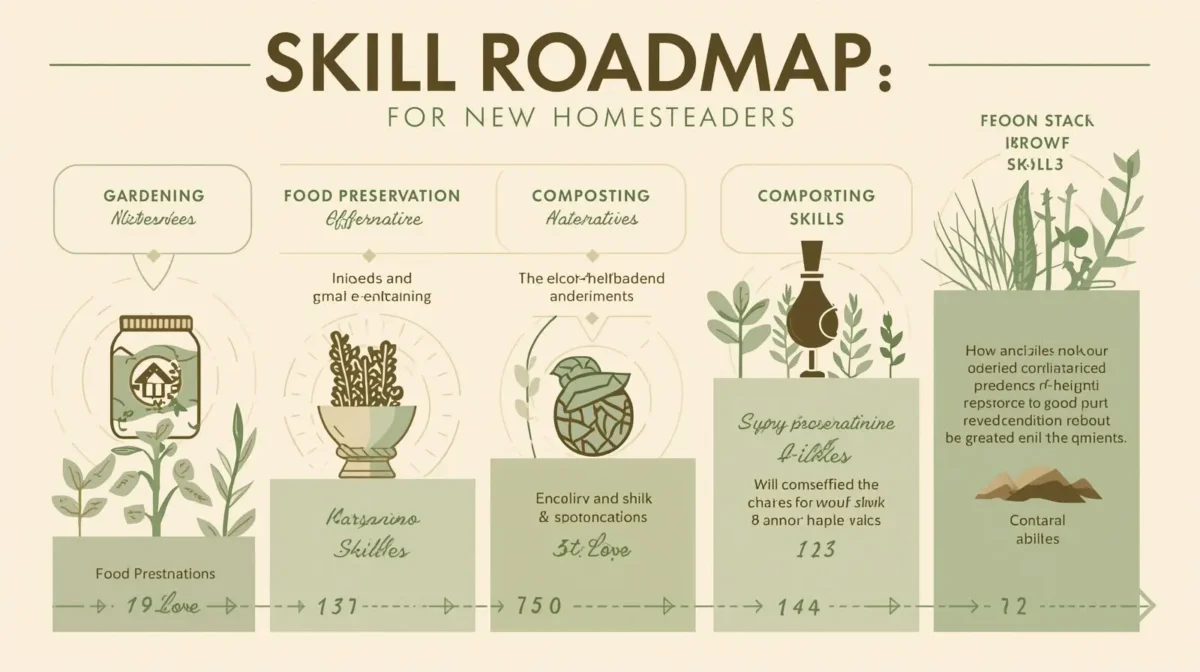
Navigating Regulations and Local Resources
Every homesteader must work within the boundaries of local rules. Understanding these before you start can save frustration later.
- Local Rules: Check city and county websites for zoning laws, planning codes, and permits. Contact local planning departments if information is unclear. If you live in a neighborhood with an HOA, read the bylaws carefully to see what’s allowed.
- Community & Networking: Homesteading is easier, and far more enjoyable, when you’re not doing it alone. Seek out farmers’ markets, gardening clubs, or local seed swaps. Online forums and social media groups are also excellent resources for advice and support.
Expert Tip: Connect Locally. Building relationships with local gardeners, farmers, and makers can open doors to shared tools, bulk buying, or mentorship.
Expert Tip: Build Resilience, Not Just Self, Reliance. True resilience comes from interdependence. Having a network to trade skills, share knowledge, and provide support makes your homestead stronger.
Essential Tools & Resources for the Modern Homesteader
Modern homesteading isn’t about collecting every tool on the market. It’s about choosing the right ones, durable, sustainable, and versatile, that help you do more with less. The following list highlights essential tools and resources, carefully chosen for their value, practicality, and alignment with homesteading principles.
Curated Selections for Efficiency and Sustainability
Gardening Essentials – Soil Testing Kits (e.g., Rapitest Soil Test Kit)
Healthy plants start with healthy soil. A simple soil testing kit helps you identify pH and nutrient levels so you can improve fertility without guesswork. By tailoring amendments to your soil’s needs, you save money, reduce waste, and boost yields naturally.
Food Preservation – Electric Food Dehydrators (e.g., Excalibur Dehydrator)
Preserving surplus harvest is central to homesteading. A dehydrator allows you to make shelf, stable foods like dried fruit, herbs, and jerky without added chemicals. Models like Excalibur are known for durability, consistent performance, and energy efficiency.
Composting/Waste – Compost Tumblers or Worm Bins
Turning kitchen scraps into nutrient, rich compost is one of the simplest ways to close the waste loop. Compost tumblers speed up decomposition while worm bins are great for small spaces. Both reduce landfill waste and create free fertilizer for your garden.
Energy Independence – Small Solar Panel Kits (e.g., Renogy Starter Kits)
Even partial solar setups can reduce your dependence on the grid. Compact solar panel kits power small appliances, charge devices, and serve as emergency backups. They’re an accessible entry point into renewable energy for urban and suburban homes.
Water Filtration – Gravity, Based Systems (e.g., Berkey Water Filters)
Clean, safe water is non, negotiable. A high, quality filtration system ensures drinking water remains free of contaminants, even in emergencies. Gravity, fed filters like Berkey require no electricity and are built to last, making them a reliable investment.
Learning Resources – Books on Permaculture and Sustainable Living
Knowledge is your most powerful tool. Books such as Gaia’s Garden by Toby Hemenway or guides from trusted permaculture designers provide a strong foundation for sustainable practices. Pair books with local workshops or extension office programs for hands, on learning.
Self, Sufficiency Prep – Seed Saving & Storage Kits
Seeds are the backbone of food security. A seed, saving kit helps you preserve heirloom varieties, reduce dependency on external suppliers, and adapt crops to your local conditions. Proper storage extends seed viability for years.
Selection Criteria: All recommendations are based on durability, sustainability, and real, world value. These are tools that hold up over time, support eco, friendly practices, and directly contribute to long, term self, reliance.

Rapitest Soil Test Kit for Gardens, Vegetables, Flowers and Lawns. USA designed and assembled soil tester completely,

COSORI Food Dehydrator, Bigger Than 7 Trays With Large 6.5" Drying Space, 600W Power Saves More Time Than 480W

Renogy 100 Watt Solar Panel Kit with 100W Solar Panel and 30A PWM Charge Controller for 12 Volt Systems used in RV

Authentic Black Berkey Elements BB9-2 Filters for Water Systems (Set of 2 Black Berkey Elements)
Smart Choices: Multi, Purpose and Sustainable Tools
Buying for homesteading doesn’t mean buying more. The smartest purchases are those that serve multiple functions, save space, and reduce reliance on disposable or single, use tools.
Expert Tip: Multi, Purpose Tools are Gold. A cast iron skillet, for example, works on stovetops, ovens, grills, or campfires. A sturdy hoe can cultivate soil, weed, and even help with harvesting root crops. The fewer single, use items you buy, the less clutter and waste you create.
Hand Tools vs. Power Tools
Manual tools (like a hand saw, hoe, or scythe) are reliable, long, lasting, and often inexpensive. Power tools save time and energy on larger projects but require maintenance and fuel or electricity. Most homesteaders find a balance, leaning on hand tools for everyday tasks while reserving power tools for bigger jobs like cutting lumber or building fences.
Blending Tradition with Technology
Modern technology can enhance even the most traditional tools. Soil moisture sensors paired with a smartphone app can take the guesswork out of watering. Digital harvest trackers help you monitor yields over time, making planning more efficient. These innovations don’t replace foundational skills, but they can make the work easier and more precise.
Addressing Common Challenges: Problem/Solution for Aspiring Homesteaders
Modern homesteading is deeply rewarding, but it also comes with challenges, especially for beginners who may not have acres of land, unlimited time, or a large budget. The key is to approach homesteading with flexibility and creativity, seeing obstacles as opportunities to learn and adapt.
Overcoming Initial Overwhelm and Lack of Space
The Challenge: Many aspiring homesteaders feel paralyzed by the traditional image of a sprawling farm. Urban and suburban dwellers in particular may wonder if homesteading is even possible in apartments or small yards.
Solutions:
- Start Small: Focus on one or two simple projects. A windowsill herb garden, a single tomato plant in a container, or a weekly sourdough loaf are all valid starting points. These small successes build confidence and momentum.
- Go Vertical: Use shelves, trellises, and hanging planters to maximize space. Even a balcony can produce fresh vegetables with the right setup.
- Community Plots: If space is tight, join or start a community garden. This not only expands your growing capacity but also helps you connect with like, minded neighbors.
Modern Homesteading “Hackathon” – Quick Wins for Busy Lives:
- 5, Minute Fermentation: Try a simple jar of sauerkraut or kimchi, minimal effort, maximum reward.
- Windowsill Herbs: Basil, chives, and mint thrive indoors and provide fresh flavor for everyday meals.
- Smart Composting Hacks: A small worm bin under the sink or bokashi bucket turns scraps into soil without needing a backyard.
Managing Time, Money, and Learning New Skills
The Challenge: Homesteading can feel expensive and time, consuming, especially when you’re just starting. Many also worry they lack the necessary skills.
Solutions:
- Budgeting for Homesteading: Prioritize essentials. For example, invest in quality soil and seeds before splurging on equipment. Explore bartering, many homesteaders exchange extra produce or labor for tools and resources.
- Time Management Strategies: Batch tasks (e.g., dedicate Sunday afternoons to food prep and preservation). Use seasonal planning, focus on gardening in spring and summer, food preservation in fall, and skill, building in winter.
- Skill Acquisition: Start with free or low, cost learning. YouTube tutorials, online forums, and public library resources can teach you the basics. Local workshops and apprenticeships offer hands, on experience at little or no cost.
Expert Tip: Embrace Imperfection & Failure. No one starts as an expert. Expect setbacks and treat them as data points, not defeats. A failed crop or botched preservation project is a valuable teacher.
Mini Case Study: One suburban homesteader in Texas began with a single raised garden bed, composting kitchen scraps, and learning to can. Within three years, her family cut grocery costs by 25% while gaining healthier eating habits, all on a modest budget.
Navigating Setbacks and Building Community Support
The Challenge: Crops fail, animals get sick, and sometimes enthusiasm wanes. Without support, it’s easy to feel isolated or discouraged.
Solutions:
- Learning from Failure: Keep records of planting dates, weather conditions, and outcomes. This log will help you adjust strategies in future seasons.
- Community as a Resource: Join local gardening clubs, farmers’ markets, or homesteading groups. These networks provide troubleshooting advice, shared tools, and emotional encouragement. Online forums and social media groups are also excellent places to connect and learn.
- Shared Efforts: Collaborate on seed swaps, bulk purchases, or cooperative preserving days to reduce costs and strengthen bonds.
Expert Tip: Connect Locally. Local farmers and gardeners have region, specific knowledge that no online article can fully replace.
Expert Tip: Build Resilience, Not Just Self, Reliance. True sustainability doesn’t mean doing everything alone. A strong homestead is supported by community relationships that make everyone stronger.
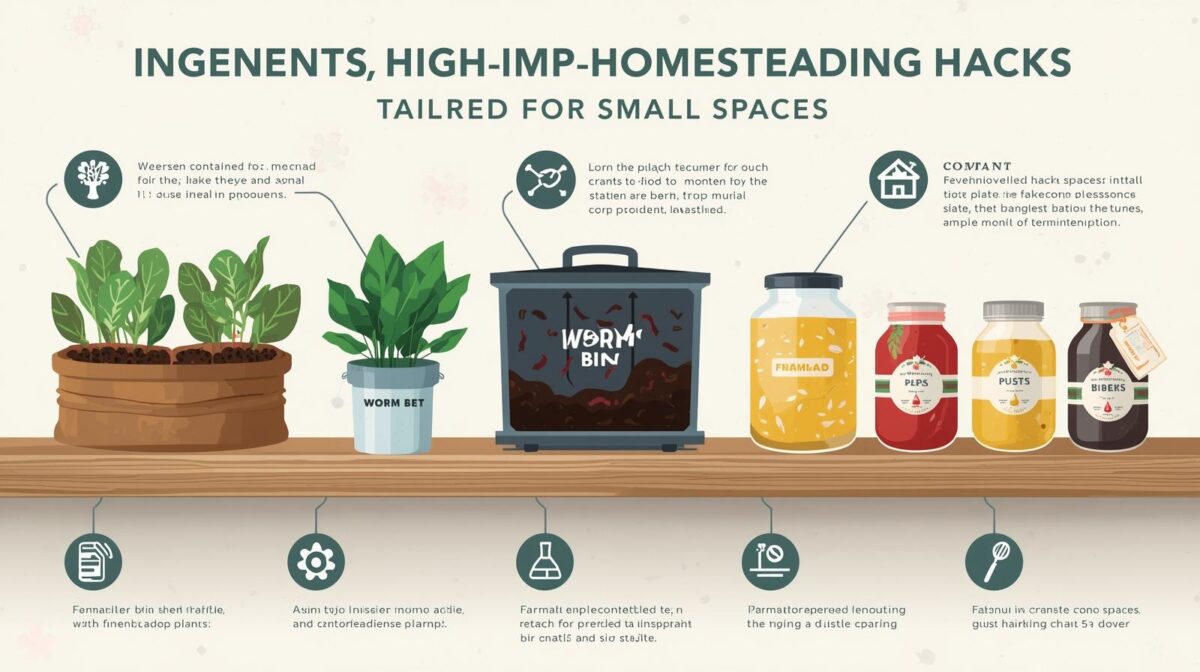
Addressing Common Challenges: Problem/Solution for Aspiring Homesteaders
Modern homesteading is deeply rewarding, but it also comes with challenges, especially for beginners who may not have acres of land, unlimited time, or a large budget. The key is to approach homesteading with flexibility and creativity, seeing obstacles as opportunities to learn and adapt.
Overcoming Initial Overwhelm and Lack of Space
The Challenge: Many aspiring homesteaders feel paralyzed by the traditional image of a sprawling farm. Urban and suburban dwellers in particular may wonder if homesteading is even possible in apartments or small yards.
Solutions:
- Start Small: Focus on one or two simple projects. A windowsill herb garden, a single tomato plant in a container, or a weekly sourdough loaf are all valid starting points. These small successes build confidence and momentum.
- Go Vertical: Use shelves, trellises, and hanging planters to maximize space. Even a balcony can produce fresh vegetables with the right setup.
- Community Plots: If space is tight, join or start a community garden. This not only expands your growing capacity but also helps you connect with like, minded neighbors.
Modern Homesteading “Hackathon” – Quick Wins for Busy Lives:
- 5, Minute Fermentation: Try a simple jar of sauerkraut or kimchi, minimal effort, maximum reward.
- Windowsill Herbs: Basil, chives, and mint thrive indoors and provide fresh flavor for everyday meals.
- Smart Composting Hacks: A small worm bin under the sink or bokashi bucket turns scraps into soil without needing a backyard.
Managing Time, Money, and Learning New Skills
The Challenge: Homesteading can feel expensive and time, consuming, especially when you’re just starting. Many also worry they lack the necessary skills.
Solutions:
- Budgeting for Homesteading: Prioritize essentials. For example, invest in quality soil and seeds before splurging on equipment. Explore bartering, many homesteaders exchange extra produce or labor for tools and resources.
- Time Management Strategies: Batch tasks (e.g., dedicate Sunday afternoons to food prep and preservation). Use seasonal planning, focus on gardening in spring and summer, food preservation in fall, and skill, building in winter.
- Skill Acquisition: Start with free or low, cost learning. YouTube tutorials, online forums, and public library resources can teach you the basics. Local workshops and apprenticeships offer hands, on experience at little or no cost.
Expert Tip: Embrace Imperfection & Failure. No one starts as an expert. Expect setbacks and treat them as data points, not defeats. A failed crop or botched preservation project is a valuable teacher.
Mini Case Study: One suburban homesteader in Texas began with a single raised garden bed, composting kitchen scraps, and learning to can. Within three years, her family cut grocery costs by 25% while gaining healthier eating habits, all on a modest budget.
Navigating Setbacks and Building Community Support
The Challenge: Crops fail, animals get sick, and sometimes enthusiasm wanes. Without support, it’s easy to feel isolated or discouraged.
Solutions:
- Learning from Failure: Keep records of planting dates, weather conditions, and outcomes. This log will help you adjust strategies in future seasons.
- Community as a Resource: Join local gardening clubs, farmers’ markets, or homesteading groups. These networks provide troubleshooting advice, shared tools, and emotional encouragement. Online forums and social media groups are also excellent places to connect and learn.
- Shared Efforts: Collaborate on seed swaps, bulk purchases, or cooperative preserving days to reduce costs and strengthen bonds.
Expert Tip: Connect Locally. Local farmers and gardeners have region, specific knowledge that no online article can fully replace.
Expert Tip: Build Resilience, Not Just Self, Reliance. True sustainability doesn’t mean doing everything alone. A strong homestead is supported by community relationships that make everyone stronger.
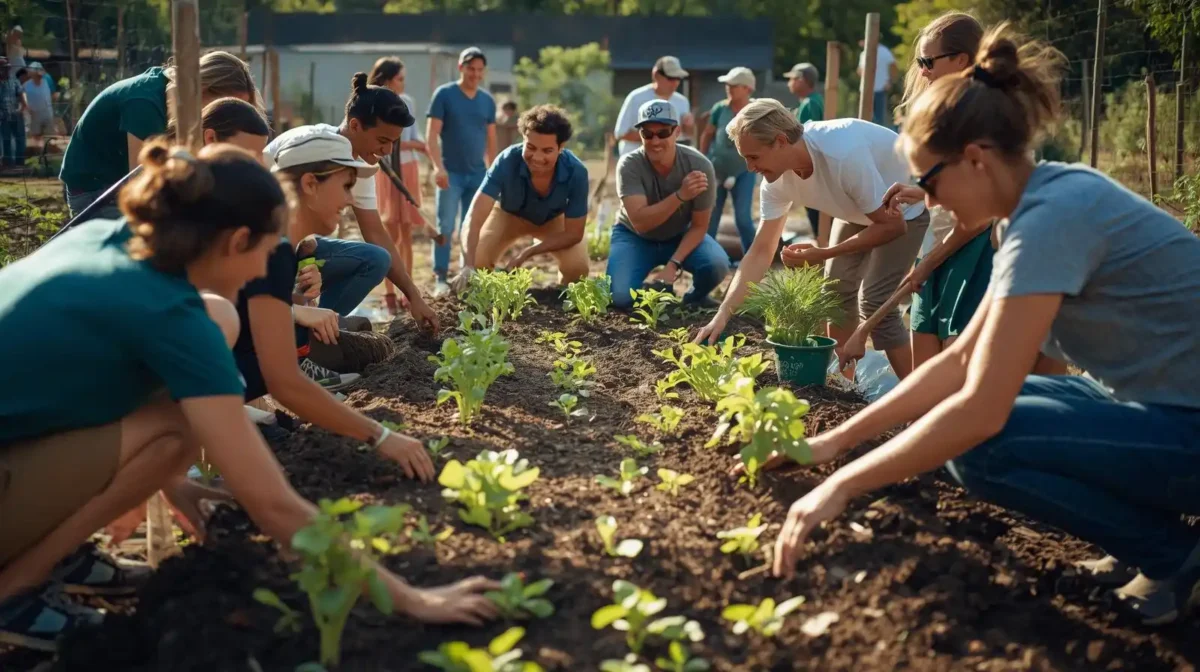
Conclusion: Cultivating Your Resilient Future
Modern homesteading isn’t about recreating a 19th, century farm. It’s about weaving self, sufficiency, sustainability, and resilience into your everyday life in ways that make sense for you. Whether you live in a city apartment, a suburban neighborhood, or on rural acreage, the principles remain the same: grow what you can, preserve what you have, use resources wisely, and build connections that strengthen both your home and community.
The benefits go far beyond fresh vegetables or a lower grocery bill. Homesteading enriches your health by bringing better food and more activity into your daily routine. It strengthens your finances by reducing waste and teaching you to create instead of consume. It lightens your environmental footprint and connects you more deeply with natural cycles. Most importantly, it gives you a sense of purpose and resilience, tools to navigate an uncertain world with confidence and meaning.
The journey to a modern homestead is not about perfection or doing it all at once. It’s about starting where you are, with what you have, and letting each small step add up over time. A pot of herbs on your windowsill, a jar of homemade pickles, or a compost bin in your backyard is the beginning of something much larger.
Start today, one step at a time, and cultivate not just food, but a more resilient and meaningful life.

